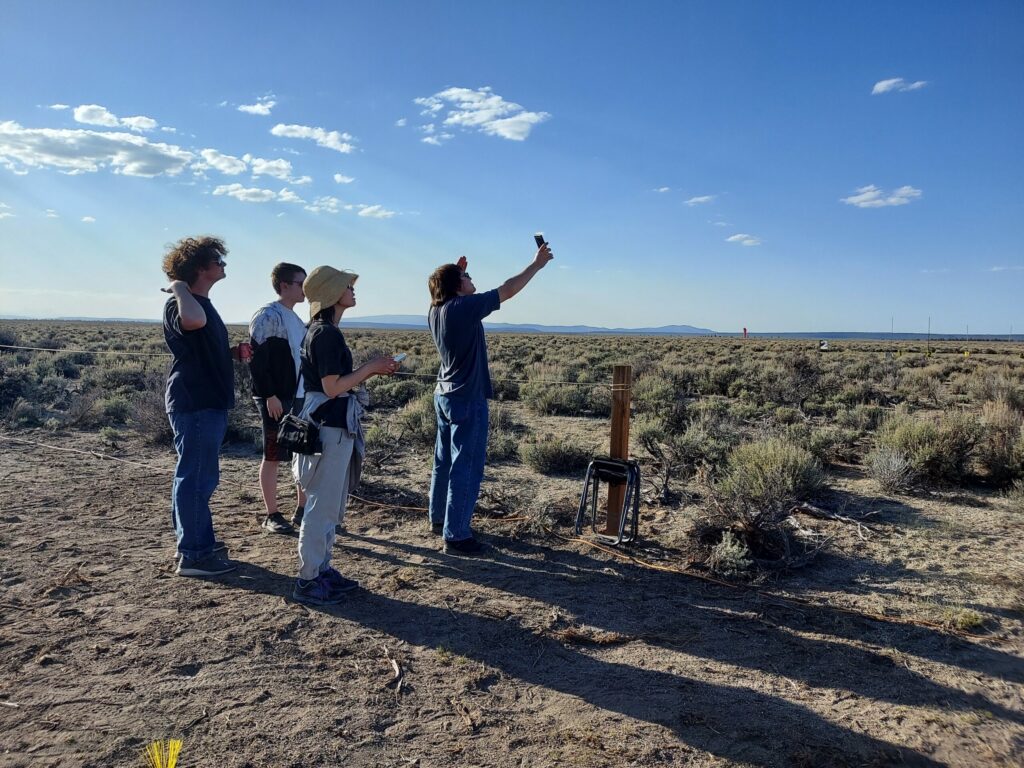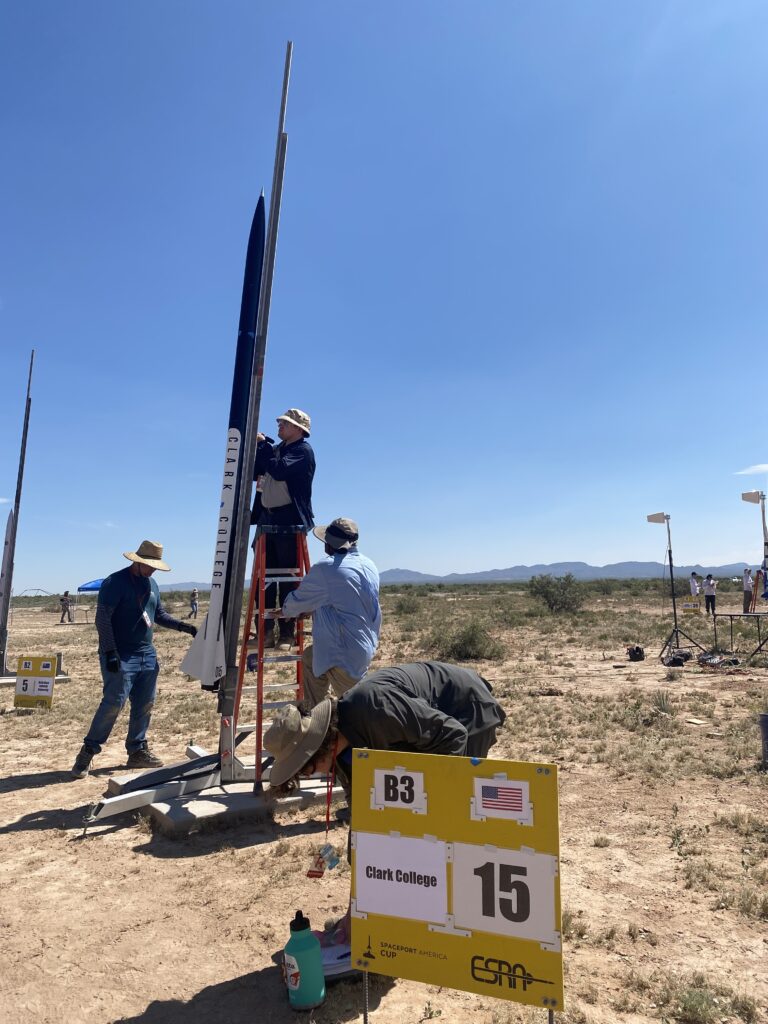Clark Aerospace students launch rocket at world’s largest international collegiate rocket competition

The Clark Aerospace team launched its rocket, Little Penguin, at Spaceport America Cup competition in Las Cruces, New Mexico in June. It is the world’s largest IREC (Intercollegiate Rocket Engineering Competition) for student rocketry teams.
Nearly 6,000 rocketeers on 158 teams hailing from 24 countries competed at Spaceport. Clark College was the only community college accepted to participate in the competition.
Xiunu “Sophie” Lin, Ph.D., Professor of Physics and Director of Clark Aerospace Program, shared the team’s video with college staff in an email: “I’m excited to share a brief video that showcases the Clark Aerospace rocket team’s incredible journey to the 2023 Spaceport America Cup competition. This video provides a glimpse into our experience at the event and offers valuable insights into our participation.”
- Watch the team’s video about their experience at Spaceport America Cup Competition here.
- Read an earlier Clark 24/7 News story about the team’s rocket test launch in April here.
Fall and winter: Building the rocket
In October 2022, a team of six Clark students, an advisor, and a mentor was organized by the Clark Aerospace program to build a rocket for the 2023 Spaceport America Cup.
Clark College Aerospace rocket team:
- Students Tyler James Lawrence, Samuel Remus Banceu, Ethan Lloyd Walters, Vyacheslav Timofeyevich Lukiyanchuk, Osvaldo Monroy, and Vee Dunn
- Mentor Jack Caynon, who guided and supported the team from beginning to end
- Xiunu “Sophie” Lin, Ph.D., Professor of Physics and Director of the Clark Aerospace Program
Rocket specs:
- Name: “Little Penguin”
- Length: 114 inches
- Diameter: 5 inches
- Weight: 39 pounds without a motor
The team spent about six months building the rocket for the competition. After several flight test failures and rebuilds, eventually, they had a rocket ready for the competition.

Spring: Test flight
Every spring, the college’s Aerospace program travels to the scrappy sagebrush landscape of Brothers, Oregon, a premier launch site for high-altitude rocket projects, 40 miles east of Bend to launch their rockets in test flights.
Clark Aerospace launched their rocket, dubbed “Little Penguin” on April 28 using an M1845 motor. According to the team’s simulations, the rocket with that motor could potentially reach a high point of about 16,000 feet (called “apogee” in rocket lingo).
Little Penguin launched—and reached an apogee of about 12,000 feet, but the team quickly lost sight of it. Several hours later, the team located their rocket 11 miles from the launch site. It was banged up and hadn’t held up as well as they’d hoped.
Dr. Lin said, “After the flight test at Brothers, we had to rebuild some parts of the rocket to make it stronger.”
Spaceport America’s Cup
Day 1 (June 18), Arrival:
Clark Aerospace team flew to Las Cruces, New Mexico, and checked in at Spaceport. One Clark Aerospace student observed: “It was thrilling to finally meet so many young rocketeers who share the same passion and dream we have about space and technology.”
Day 2, Project Presentation:
Clark Aerospace showcased their rocket at Las Cruces Convention Center. The team’s rocket attracted much attention. Next, the team took their rocket through the flight safety review. Eventually, they were granted permission to fly the following day.
The night before the launch, students worked in the garage of the Airbnb house to correct some minor issues identified during the flight safety review. Together, they prepared the rocket for the next day’s launch.
Day 3, Scheduled Launch Day:
Students worked on the rocket to earn the opportunity to launch the rocket on the first day and accumulate more points. They took the rocket to the flight readiness safety inspection, where the launch control officer reviewed their rocket. It passed the final safety check. They were cleared to take their rocket to the launch site.
Unfortunately, strong winds picked up in the late afternoon. All launch events were suspended. Little Penguin would have to wait another day to fly.
Day 4, Second Launch Day:
The students awoke at 3 a.m. and lined up at the gate of the launch site at 6 a.m. Building their rocket in the early morning light, Clark Aerospace was in the first group of teams to set up the tent and work on their rockets.
One student said, “We were trying all we could to earn an edge to compete with the four-year universities. There is not much difference between us and the students from four-year universities, as long as we are willing to work as hard, or even harder than them.”
Just like the previous day, they lined up for the flight readiness safety inspection. They were given the green light to take their rocket to the vertical launch site, where they set up their rocket. Then they settled into the bleachers to watch Little Penguin fly.
The launch site announcer said: “We’re looking at Clark College. This is a community college. It’s good to see community colleges participate. You don’t have to be a major Division 1 school. You just need students who have the passion and interest, a little bit of support from the community and the school. Clark Aerospace is launching from Pad B3. Skies are clear. LCO (launch control officer) is counting it down. Launching in 5-4-3-2-1!”
The rocket lifted up. For this flight, the team had attached an M1419 motor. The rocket reached an apogee of 8,529 feet. Little Penguin was recovered about 200 feet away from the launchpad, a new record for the rocket team.
Dr. Lin said, “Our program’s projects offer a valuable chance for students to voluntarily step up and take on responsibility, enabling them to delve deeper into their true potential and explore the possibilities of who they can become.”
Spaceport America Cup by the numbers:
- 5,913 rocketeers participating
- 158 teams
- 1,329 (22%) of participants were women
- Students hailed from 24 countries on 6 continents
(Algeria, Argentina, Australia, Brazil, Canada, Denmark, Egypt, Germany, Greece, India, Italy, Nepal, Malaysia, Mexico, New Zealand, Poland, Romania, South Korea, Thailand, Turkey, Ukraine, United Arab Emirates, United Kingdom, United States)
Next challenge: Spaceport 2024
The next challenge for Clark Aerospace: Building their project to compete in the next Spaceport America Cup competition in June 2024. The team plans to make their own motor, build a six-inch diameter rocket, and compete in the SRAD (Student Researched and Designed) 10,000-foot category.
Interested in joining?
Clark Aerospace is looking for interested Clark students to join them. No prior experience with rockets is required.
Clark’s Aerospace Club actively participates in science, technology, engineering, and math-based experiential project/aerospace design competitions, and students also attend launch events, museums, and aerospace-related activities.
To learn more: Email clarkaerospace1@gmail.com













